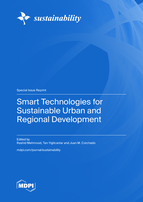Smart Technologies for Sustainable Urban and Regional Development
A special issue of Sustainability (ISSN 2071-1050). This special issue belongs to the section "Sustainable Urban and Rural Development".
Deadline for manuscript submissions: closed (31 August 2023) | Viewed by 37051
Special Issue Editors
Interests: high-performance computing (HPC); big data; AI and IoT with applications in smart cities, healthcare, transportation, logistics, and toxicology
Special Issues, Collections and Topics in MDPI journals
Interests: smart technologies, communities, cities and urbanism; knowledge-based development of cities and innovation districts; sustainable and resilient cities; communities and urban ecosystems
Special Issues, Collections and Topics in MDPI journals
Interests: artificial Intelligence; machine learning; edge computing; distributed computing; Blockchain; consensus model; smart cities; smart grid
Special Issues, Collections and Topics in MDPI journals
Special Issue Information
Dear Colleagues,
The complexities of contemporary and emerging living spaces, cities, and societies are on the rise, endangering the sustainability of everything, be it individuals, families, institutions, governments, cities, societies, businesses, economies, or our planet. The deteriorating state of social, environmental, and economic sustainability is manifest in the frequency and severity of natural pandemics and disasters, civil unrest, international wars, torn social fibres across societies, racial and economic inequities, etc. The UN’s sustainable development goals (SDGs) accentuate the need for urgent, holistic, and collaborative action on the triple bottom line (TBL), i.e., social, environmental, and economic sustainability.
While complexities are on the rise, never before have we been equipped with the advanced technologies of today to monitor, analyse, make decisions, and act on the environment [1,2]. These technologies include, among others, miniaturization and digitisation of sensors and actuators, social and virtual sensing, Internet of Things (IoT), data-driven methods, AI-driven insights and optimisations, digital twins, and cloud, fog, and edge computing. These technologies are transforming into things of science fiction such as flying cars, autonomous systems, robots, drones, and self-driving vehicles.
While technologies are revolutionising our lives, we could also use them to perpetually develop, monitor, and improve policies, strategies, legislation, processes, and procedures that embed, maintain, and protect TBL sustainability in our cyber-physical world. That is, technological advancements such as the Internet of Things (IoT), big data, and machine learning have made it possible to create autonomous systems that allow us to monitor processes in real-time and at a much finer level and perpetually improve policies, procedures, and infrastructure to protect TBL sustainability. There is a need to understand and fully exploit the benefits of the emerging technologies to develop autonomous systems that are built to be intrinsically sustainable. Research efforts are needed at both the policy and infrastructure levels. A particular technology of interest here is “green artificial intelligence” or “green AI” that “moves away from short-term efficiency solutions to focus on a long-term ethical, responsible and sustainable AI practice that will help build sustainable urban futures for all through smart city transformation” [2].
This Special Issue invites papers proposing systematic approaches towards the development of smart digital technologies for the conception, innovation, design, and operation of systems for sustainable urban and regional development. The submissions can be research papers, case reports, viewpoints, or literature reviews.
We welcome manuscripts that contribute to policy, strategy, legislation, process, or infrastructure development or their interfaces. The intention of this approach is to invite submissions that will enable us to develop a holistic overview such that different communities working in policy and infrastructure research can establish a dialogue and understand the cross-disciplinary issues and collaboratively devise holistic and globally optimum solutions for sustainable development.
References
- Alotaibi, S.; Mehmood, R.; Katib, I.; Rana, O.; Albeshri, A. Sehaa: A Big Data Analytics Tool for Healthcare Symptoms and Diseases Detection Using Twitter, Apache Spark, and Machine Learning. Sci. 2020, 10, 1398.
- Yigitcanlar, T.; Mehmood, R.; Corchado, J.M. Green Artificial Intelligence: Towards an Efficient, Sustainable and Equitable Technology for Smart Cities and Futures. Sustainability 2021, 13,
Prof. Dr. Rashid Mehmood
Prof. Dr. Tan Yigitcanlar
Prof. Dr. Juan M. Corchado
Guest Editors
Manuscript Submission Information
Manuscripts should be submitted online at www.mdpi.com by registering and logging in to this website. Once you are registered, click here to go to the submission form. Manuscripts can be submitted until the deadline. All submissions that pass pre-check are peer-reviewed. Accepted papers will be published continuously in the journal (as soon as accepted) and will be listed together on the special issue website. Research articles, review articles as well as short communications are invited. For planned papers, a title and short abstract (about 100 words) can be sent to the Editorial Office for announcement on this website.
Submitted manuscripts should not have been published previously, nor be under consideration for publication elsewhere (except conference proceedings papers). All manuscripts are thoroughly refereed through a single-blind peer-review process. A guide for authors and other relevant information for submission of manuscripts is available on the Instructions for Authors page. Sustainability is an international peer-reviewed open access semimonthly journal published by MDPI.
Please visit the Instructions for Authors page before submitting a manuscript. The Article Processing Charge (APC) for publication in this open access journal is 2400 CHF (Swiss Francs). Submitted papers should be well formatted and use good English. Authors may use MDPI's English editing service prior to publication or during author revisions.
Keywords
- smart technologies for sustainable urban and regional development
- big data analytics and systems for sustainable development
- green artificial intelligence (AI) for sustainable development
- smart and sustainable pandemic and disaster prevention and management
- sustainable, autonomous and electric mobility
- participatory and electronic governance for sustainable development
- knowledge-based society, economy and governance for sustainable development
- data-driven and evidence-based governance for sustainable development
- blockchain technology for sustainable development
- Industry 4.0/5.0 for sustainable development
- vertical agricultural farms for sustainable development
- digital twin technologies for sustainable development
- creativity and innovation for sustainable development
- tolerance, collaboration and competitiveness for sustainable development
- intellectual, human and social capital for sustainable development
- healthcare, quality of life and liveability for sustainable development
- education and lifelong learning for sustainable development
- digital and physical infrastructure for sustainable development
- 5G and 6G telecommunication technologies and infrastructure to support sustainable development
- cloud, fog, edge and distributed computing for sustainable development
- smart homes and precincts for sustainable development
- privacy, safety and security technologies for sustainable development
- smart buildings and built environment for sustainable development
- renewable energies for sustainable development
- social, economic and environmental resilience theories and technologies for sustainable development








